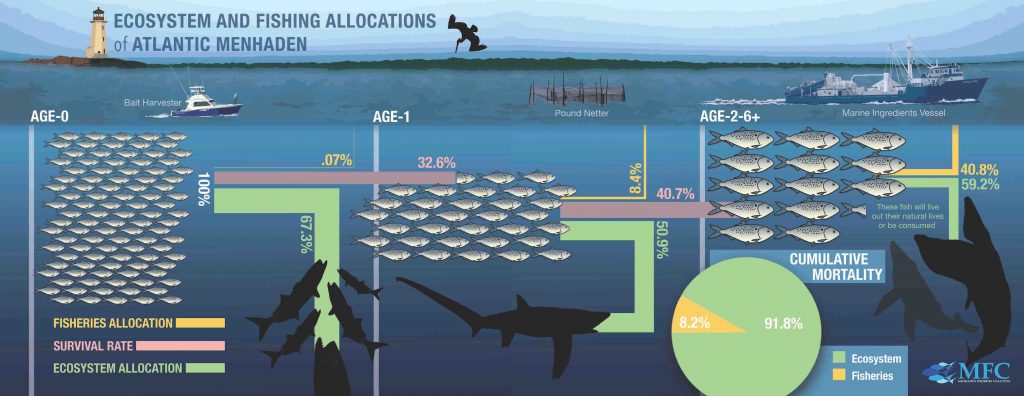Analysis Challenges Arguments That Interim Ecological Reference Points Are Urgently Needed

An analysis finds that 92 percent of Atlantic menhaden are left in the water to serve their ecological role. A high quality version of this infographic is available by clicking on the image.
WASHINGTON – November 9, 2017 – The following was released by the Menhaden Fisheries Coalition:
 A new analysis from the Menhaden Fisheries Coalition (MFC) finds that current management leaves 92 percent of Atlantic menhaden to serve their ecological role as forage for predators. The analysis is based on data from the Atlantic States Marine Fisheries Commission’s (ASMFC) 2017 update stock assessment of Atlantic menhaden. The MFC has produced an infographic illustrating this analysis, which is available here.
A new analysis from the Menhaden Fisheries Coalition (MFC) finds that current management leaves 92 percent of Atlantic menhaden to serve their ecological role as forage for predators. The analysis is based on data from the Atlantic States Marine Fisheries Commission’s (ASMFC) 2017 update stock assessment of Atlantic menhaden. The MFC has produced an infographic illustrating this analysis, which is available here.
In recent weeks, numerous ENGOs and recreational fishing groups up and down the Atlantic Coast have published articles and op-eds arguing that menhaden are in dire need of greater protection. These groups include the Pew Charitable Trusts, the Chesapeake Bay Foundation, the American Sportfishing Association, and local activists from coastal states like Rhode Island and New Jersey. However, the MFC’s analysis challenges the assertion that fisheries take too many menhaden, and makes clear that the vast majority of fish are already left in the water to fulfill their ecological role.
The analysis tracks an average menhaden year class through its full life cycle. It finds that two-thirds of juvenile menhaden (younger than age 1) are either consumed by predators or die of natural causes. These juvenile menhaden are the preferred forage for predator species and are not targeted by the fishery, which takes less than 1 percent of these fish.
Over half of the menhaden that survive to age-1 are allocated to the ecosystem to be eaten by predators such as striped bass and marine birds or die of natural causes. Only 8 percent of age-1 menhaden are harvested by the fishery.
The menhaden fishery largely harvests menhaden over the age of 2, but even for this age group, it only harvests about 40 percent of fish. Overall, just 8 percent of a menhaden year class is harvested by the fishery. The overwhelming majority of fish – 92 percent – are not impacted by the fishery.
This MFC analysis is an update of a previous analysis that was based on the ASMFC’s 2015 benchmark stock assessment of Atlantic menhaden. That analysis was reviewed by the ASMFC last fall. Both the 2015 benchmark assessment and the 2017 update assessment found that Atlantic menhaden is neither overfished nor experiencing overfishing.
